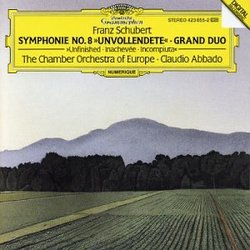| All Artists: Franz Schubert, Claudio Abbado Title: Schubert: Symphony No 8; Grand Duo Members Wishing: 1 Total Copies: 0 Label: Deutsche Grammophon Original Release Date: 1/1/1989 Re-Release Date: 5/2/1989 Album Type: Import Genre: Classical Style: Symphonies Number of Discs: 1 SwapaCD Credits: 1 UPCs: 028942365520, 0028942365520 |
Search - Franz Schubert, Claudio Abbado :: Schubert: Symphony No 8; Grand Duo
 | Franz Schubert, Claudio Abbado Schubert: Symphony No 8; Grand Duo Genre: Classical
|
Larger Image |
CD Details |
CD ReviewsA Noteworthy "Unfinished" Really Finished Paul S. Rottenberg | Ft. Lauderdale, FL | 09/17/2008 (5 out of 5 stars) "Franz Finished
Why did Schubert leave these two tremendous movements of his B minor Symphony incomplete? Actually, he worked on a scherzo, but left it incomplete, orchestrating about half (up to the Trio) and leaving the rest in piano score. There used to be a recording in the 60s of exactly what Schubert left, the usual two movements, with the scherzo, the orchestration ending abruptly, followed by the piano sketches for the rest. I don't recall the conductor, but I think the orchestra was the Vienna State Opera, on Columbia's budget label Odyssey. This is, as far as I know, out of print. At any rate, we now have the perfectly good completions of various unfinished orchestral scores of Schubert ( he left several fragments of projected symphonic, chamber, and piano works) published by Dr. Brian Newbould, and we can point out the recording by Neville Marriner of the finished version of the "Unfinished," on Phillips as the most noteworthy of these. However, this still doesn't quite give us exactly what Schubert wrote in the works and portions of works he did complete. Brahms and other well-meaning editors are responsible for the versions of Schubert's symphonic output we're all familiar with, but this is NOT the last word. Enter Claudio Abbado in the 1980s, and Nikolas Harnoncourt in the 90s. First Abbado, with the Chamber Orchestra of Europe on DG (reviewed here), and then Nikolaus Harnoncourt, with the Concertgebouw Orchestra on Teldec, both made the first recordings of Schubert's Symphonies as he wrote them. In the case of the present work, the Symphony in B Minor, recorded by Abbado and the COE, we get a first movement which seems to be the same as ever, but only up to the repeat of the exposition; thereafter, things are different. The famous tremelando chords are repeated (Abbado takes all of Schubert's repeats, to satisfying effect), and unfamiliar harmonies and inner details of trumpet and winds may surprise the most veteran of listeners. The second movement is less surprising, but equally compelling. We seem to be in a different world from that we usually see as Schubert's. There is the Alpine depth and nostalgia (with Mahler just "off stage"), but from a different perspective. The excellent, smaller forces gives us a view of inner lines usually not heard or not much noticed. Abbado is, as always in this series of Schubert Symphonies, masterly, allowing the music to speak for itself, much as Szell did in his classic recording of Nos. 8 & 9. The "Grand Duo," actually a sonata for one piano, four hands (two players), is an orchestration by Brahms' and Schumann's friend and colleague Joseph Joachim. He did an excellent job, bringing out what Schumann saw as a "hidden symphony," and this is an excellent performance, easily the best of the work in orchestral score, and one of the best versions overall, equaling the splendid performance of Radu Lupu and Daniel Baremboim on Teldec. So, why did Schubert leave his great B Minor Symphony unfinished? Perhaps we'll never know exactly, but there are intriguing theories mentioned in the notes for this recording as well as in Dr. Newbould's book Schubert: the Music and the Man. We'll leave it at that. See the review of the complete recording of Schubert's Symphonies on DG. Finally, the most radical version of the B Minor would consist of the first two movements done by Abbado, followed by the scherzo done by Marriner,with the possible finale played by Abbado, from his "Rosamunde" with the COE on DG. " |

 Track Listings (6) - Disc #1
Track Listings (6) - Disc #1